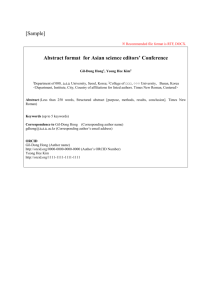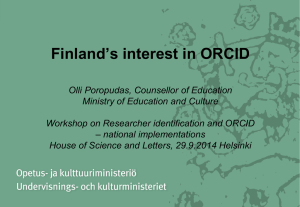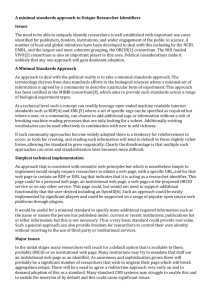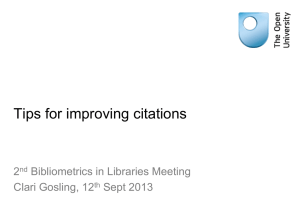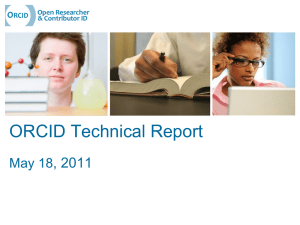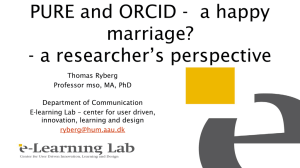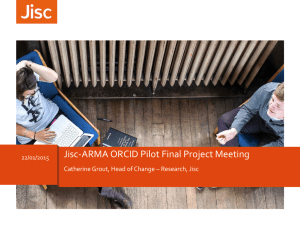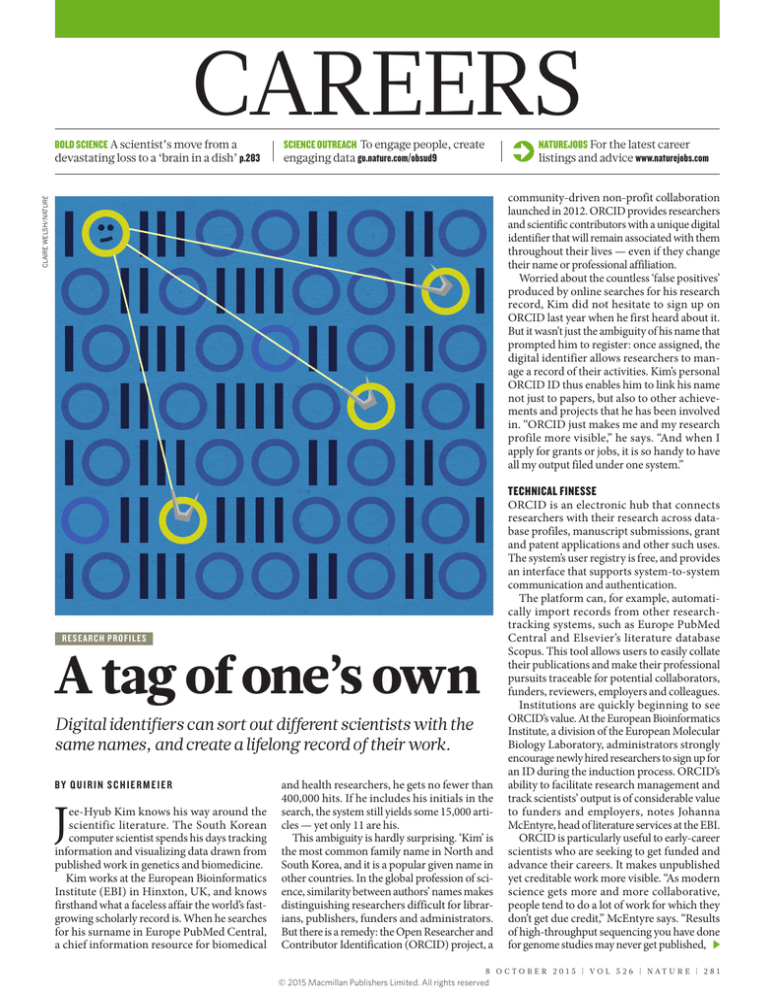
CAREERS
CLAIRE WELSH/NATURE
BOLD SCIENCE A scientist’s move from a
devastating loss to a ‘brain in a dish’ p.283
SCIENCE OUTREACH To engage people, create
engaging data go.nature.com/obsud9
I III
II
II IIII
I III
II
II IIII
II
I III
II IIII
I III
II
RES E ARCH PRO FILES
NATUREJOBS For the latest career
listings and advice www.naturejobs.com
II
I I
II
I I
II
I I
II
A tag of one’s own
Digital identifiers can sort out different scientists with the
same names, and create a lifelong record of their work.
BY QUIRIN SCHIERMEIER
J
ee-Hyub Kim knows his way around the
scientific literature. The South Korean
computer scientist spends his days tracking
information and visualizing data drawn from
published work in genetics and biomedicine.
Kim works at the European Bioinformatics
Institute (EBI) in Hinxton, UK, and knows
firsthand what a faceless affair the world’s fastgrowing scholarly record is. When he searches
for his surname in Europe PubMed Central,
a chief information resource for biomedical
and health researchers, he gets no fewer than
400,000 hits. If he includes his initials in the
search, the system still yields some 15,000 articles — yet only 11 are his.
This ambiguity is hardly surprising. ‘Kim’ is
the most common family name in North and
South Korea, and it is a popular given name in
other countries. In the global profession of science, similarity between authors’ names makes
distinguishing researchers difficult for librarians, publishers, funders and administrators.
But there is a remedy: the Open Researcher and
Contributor Identification (ORCID) project, a
community-driven non-profit collaboration
launched in 2012. ORCID provides researchers
and scientific contributors with a unique digital
identifier that will remain associated with them
throughout their lives — even if they change
their name or professional affiliation.
Worried about the countless ‘false positives’
produced by online searches for his research
record, Kim did not hesitate to sign up on
ORCID last year when he first heard about it.
But it wasn’t just the ambiguity of his name that
prompted him to register: once assigned, the
digital identifier allows researchers to manage a record of their activities. Kim’s personal
ORCID ID thus enables him to link his name
not just to papers, but also to other achievements and projects that he has been involved
in. “ORCID just makes me and my research
profile more visible,” he says. “And when I
apply for grants or jobs, it is so handy to have
all my output filed under one system.”
TECHNICAL FINESSE
ORCID is an electronic hub that connects
researchers with their research across database profiles, manuscript submissions, grant
and patent applications and other such uses.
The system’s user registry is free, and provides
an interface that supports system-to-system
communication and authentication.
The platform can, for example, automatically import records from other researchtracking systems, such as Europe PubMed
Central and Elsevier’s literature database
Scopus. This tool allows users to easily collate
their publications and make their professional
pursuits traceable for potential collaborators,
funders, reviewers, employers and colleagues.
Institutions are quickly beginning to see
ORCID’s value. At the European Bioinformatics
Institute, a division of the European Molecular
Biology Laboratory, administrators strongly
encourage newly hired researchers to sign up for
an ID during the induction process. ORCID’s
ability to facilitate research management and
track scientists’ output is of considerable value
to funders and employers, notes Johanna
McEntyre, head of literature services at the EBI.
ORCID is particularly useful to early-career
scientists who are seeking to get funded and
advance their careers. It makes unpublished
yet creditable work more visible. “As modern
science gets more and more collaborative,
people tend to do a lot of work for which they
don’t get due credit,” McEntyre says. “Results
of high-throughput sequencing you have done
for genome studies may never get published,
8 O C T O B E R 2 0 1 5 | VO L 5 2 6 | NAT U R E | 2 8 1
© 2015 Macmillan Publishers Limited. All rights reserved
DUAL DIRECTIONS
For the purpose of authentication, ORCID
records do display the source — if available
— of claimed professional affiliations. If a scientist says that she or he is employed by the
University of Oxford, UK, for example, and the
university has in turn verified that the individual works for them, that is visible in the system.
With millions of researchers worldwide,
and so many similar names, allowing institutions to confirm researcher affiliations helps
O RCI D BLO O M
Tips for profile growth
●●In your profile, list all variations and
abbreviations (including initials) of your
name, and any previous iterations used
in a professional context.
●● Carefully choose the privacy settings
that best suit your needs.
●●Link ORCID with other identifiers
and research profiles that you use. For
example, if you have a Researcher ID
or Scopus Author ID, you can import
information from those systems into
your ORCID record.
●●ORCID can handle a large variety of
scholarly output other than scientific
articles. Check out what data sets and
figures you can link to your profile.
●●Make sure to keep your record
updated.
●●Provide your ORCID ID when
submitting manuscripts and applying for
grants. Include it in your e-mail signature
and CV, and add it to your social-media
accounts. Q.S.
NOW 1.5 MILLION STRONG AND GROWING
ORCID’s digital identifiers link scientists with publications and contributions. Sign-ups have increased by
more than 50,000 a month since the beginning of 2015.
2.0
Number of registrations (millions)
for example. On ORCID, you can claim that
data, and draw attention to any other contributions to collaborative research that may help
raise your profile.”
To creative minds, assigning a number
might conjure up Orwellian associations. But
ORCID users have a lot of control. They can
choose different levels of privacy for their digital content, and change these settings at any
time. They can make some records publicly
available and others visible only to trusted parties. And if they wish to list specific works, data
or funding sources solely for their own reference, the information can be entirely hidden.
“ORCID is an opt-in system,” says Laurel
Haak, the system’s executive director in
Bethesda, Maryland. “We do not collect
any private information other than e-mail
addresses, which the researcher can set as private so that it is not shared.” Privacy concerns
have not been a barrier to ORCID’s adoption
at the EBI, says McEntyre. “If I really want to
find out about you, I just google your name,”
she says. “A digital ID doesn’t tell you a lot.”
September 2014
The Denmark Consortium
decides to integrate
ORCID nationwide.
1.6
1.2
August 2013
ORCID is linked
to Europe
PubMed Central.
0.8
0.4
0
August 2015
Wellcome Trust makes
ORCID registration
mandatory.
October 2012
Launch.
Oct
Jan
2013
Apr
Jul
Oct
Jan
2014
to ward off concerns that someone could take
advantage of name ambiguity. But Josh Brown,
ORCID’s regional director for Europe, says that
if researchers were tempted to claim papers or
data that they didn’t actually produce, it would
hardly go unnoticed. “The idea is that ORCID
data that is shared between systems is open for
validation and cross-checking by those systems,” he says. “By displaying provenance and by
the nature of the data itself — which tends to be
publicly available or verifiable — any misuse can
be detected by the people best placed to do so.”
All 500 or so staff scientists at the EBI have
signed up for an ID. So have most scientists at
other branches of the European Molecular Biology Laboratory, located in the United Kingdom,
Germany, France and Italy. In turn, many science journals (including Nature, which partners
with ORCID) encourage its use, with the goal of
optimizing the manuscript-submission process.
Funding agencies are following suit. To
streamline the handling of grant applications,
the Wellcome Trust in London has required
all applicants since 1 August to provide an
ORCID ID. Similarly, the European Research
Council, run by the European Commission, has
begun asking grant applicants for their IDs —
although providing one is not mandatory — so
that reviewers can better gauge their skills and
contributions to science. And the US National
Institutes of Health is testing ORCID’s efficacy
for linking researchers and their outputs.
ORCID is rapidly becoming the default
global research-management system, says Liz
Allen, head of evaluation at the Wellcome Trust.
She thinks that scientists should sign up for an
ID early in their career and strive to keep their
profiles up to date (see ‘Tips for profile growth’).
“ORCID helps young scientists arrive and
settle in the research ecosystem,” says Allen. “It
allows you to distinguish your skills from those
of co-authors and competitors. And it helps
you spend more time doing research and find
people to collaborate with, rather than filling
out personal information on countless forms.”
Creating a profile is simple. Once a researcher
provides a name and an e-mail address, that
2 8 2 | NAT U R E | VO L 5 2 6 | 8 O C T O B E R 2 0 1 5
© 2015 Macmillan Publishers Limited. All rights reserved
Apr
Jul
Oct
Jan
2015
Apr
Jul
individual is assigned a 16-digit number. The
ORCID ID is then expressed as a web address to
which any publications and personal details can
be posted or imported from data repositories.
“It took virtually no time to register,” says
Nadarajen Veerapen, a software developer at
the University of Stirling, UK, who specializes
in process optimization. “Once you’re linked to
different systems, ORCID is very practical and
easy to handle. But you should really use your
ID and not just leave it idle.”
Researchers generally have to maintain an
ORCID profile manually. Whether it is acceptable for employers to create ORCID profiles
for their staff and feed the system with data
from in-house publication databases is still
under discussion. “From our point of view, it
would make a lot of sense. But there are technical and legal issues that need to be addressed,”
says Bernhard Mittermaier, a librarian at the
Jülich Research Centre in Germany.
GLOBAL WAVE
ORCID stretches across all disciplines and
continents. Worldwide, more than 1.5 million
users have signed up since its launch (see ‘Now
1.5 million strong and growing’).
Not everyone maintains their profiles diligently — in fact, many ORCID users list no
output at all. But as the facility gets better known
and more widely accepted, the value of its information will increase. As of August, more than
400,000 of the 3.3-million full-text articles listed
on Europe PubMed Central were linked to at
least one ORCID ID. Some multi-author articles
are claimed by several dozen ORCID IDs. And
prolific authors and users, such as EBI genome
researcher Nick Goldman, have co-written
nearly 100 ORCID-claimed papers.
As more people sign up, Allen says, ORCID
promises to become a powerful tool for tracking and maximizing the research value of grants,
avoiding duplicate funding and identifying
opportunities for collaborative research. In June,
the British Library in London started to include
ORCID IDs in its national thesis service, which
provides free access to doctoral theses done at
SOURCE: LAUREL HAAK/ORCID
CAREERS
SUSAN MCKAY
CAREERS
UK higher-education institutes. In the same
month, a group of Italian research organizations announced that it would implement
ORCID nationwide, aiming for 80% of
Italian researchers to have an ID by 2016.
The system is still developing. To recognize scientists’ peer-review activities
— time-consuming work that tends to
remain invisible — ORCID is discussing
with publishers ways to enable scientists to
add reviews to their profiles. “We don’t get
acknowledged” for such work, says Veerapen. “It would be really good if funders and
employers were able to check what service
I’m doing for science in that respect, too.”
There are downsides to using ORCID.
The web interface is not perfect, and it is
still inconvenient to search, says McEntyre.
Others note that ORCID’s connectivity with
research-tracking systems and databases
could be improved. And still missing, Kim
says, is a format for registering the software
products that often emerge from datagenerating research such as his. Haak says
that such technical issues will be tackled
in consultation with ORCID’s 350 or so
member organizations, most of which are
in Europe, Asia and North America.
But ORCID’s strengths — author-name
disambiguation and the opportunity to
specify unpublished contributions to science — appeal all the same to scientists and
research agencies in other parts of the world.
“ORCID is ideal for developing science
markets,” says Matthew Buys, ORCID’s
regional director for Africa and the Middle
East. “It sits really
well with the com- “ORCID helps
munity in Africa young scientists
— not just because
arrive and
there are many
settle in the
s h are d n am e s
research
there, but because
funders, publish- ecosystem.”
ers and institutions understand that they need to connect
to bring high-quality research to Africa.”
With 4,500 assigned IDs, South Africa is
the best-represented country on its continent. But excitement about ORCID’s value
is growing in Africa and in the Middle East,
Buys says. ORCID’s outreach workshops in
developing countries — such as one held in
July in Nairobi — are well attended.
Ayodele Alonge, a PhD student at the
University of Nairobi’s School of Journalism
and an emerging-technology librarian at
the University of Ibadan in Nigeria, signed
up for ORCID immediately after learning
about it in May. “ORCID enhances my visibility as an upcoming researcher,” he says.
“And I hope it’ll help me get recognized for
what I’m doing.” ■
Quirin Schiermeier is Nature’s Germany
correspondent.
TURNING POINT
René Anand
After Hurricane Katrina destroyed his lab
at Louisiana State University in 2005, René
Anand embraced high-risk research — projects
that might win big or fail completely. Anand
tells Nature how that decision led him to create
what he considers the most-advanced brain
model developed so far.
You began a career doing molecular biology.
What sparked your interest in neuroscience?
When I got my PhD at Ohio State University in
1989, I was investigating how genes recombine.
I moved on to a postdoc at the Salk Institute for
Biological Studies in La Jolla, California, where
my informal training in neuroscience started. It
was the obvious next frontier in science.
How did Hurricane Katrina affect your lab?
Katrina destroyed the lab itself. The building
was flooded with water for a month — the
whole system closed down. I lived on the outskirts of town, relying on food from aid organizations and writing grants. A lot of people,
mostly clinicians, lost their jobs. Those dark
days lasted a year. We chose to move mostly for
family reasons — schools were disruptive — not
because we didn’t foresee recovery. But it was
scary to think that something like this could
derail us again. Science is already demanding
enough. I went back to Ohio State in 2007 — I
wanted something familiar and to be part of an
interdisciplinary campus.
In 2010, you got a US National Institutes of
Health grant. Was that a game-changer?
Yes — I was rewarded for being a risk-taker.
The EUREKA (Exceptional, Unconventional
Research Enabling Knowledge Acceleration)
grant was designed to help investigators to
pursue innovative ideas. I wanted to understand at the genomic level how an electric eel’s
membrane proteins work, so that we could
study human diseases involving similar proteins. Getting that grant played a big part in my
attempt to turn stem cells into a brain organoid.
How did you decide to create a brain model?
It grew out of my fundraising work with
Autism Speaks, a US charity that supports
basic research. Year after year, I sat with families and listened to them talk about how much it
mattered to them what scientists do. I developed a very personal connection that drove me
to take risks. At the time, I was doing research
in rodents that failed miserably. I had to find
another way, so that I could work in a species
that could give us more insight. Using stem cells
as the basis for an organoid offered that bridge.
We were fortunate to find two risk-taking
funders that gave us roughly US$140,000. We
spent four years producing a stem-cell-based
brain organoid using adult human skin cells.
What was the reaction to this ‘brain in a dish’?
I should be clear that this ‘brain’ models
early-developmental tissue and is roughly
2–3 millimetres long. It expresses more than
98% of the genes present in a human brain at
5 weeks of development. We are not capable
of addressing higher-order function, such as
memory, learning or cognition. But we can
see structures of the brain, and perhaps use
the model to see how it responds to drugs. The
organoid might be useful for high-throughput
screening for therapeutic-drug discovery or
toxicity testing. We are working through legal
issues, such as intellectual-property rights. I
have the paper ready to submit as soon as we
get the business concerns addressed. I didn’t
realize that the world of commercialization is
as challenging to navigate as the science.
How did word about the model get out if the
paper is not yet published?
We finished the project in April 2014. As we
grew more confident in our results, I shared
them at conferences, including an invited talk
at the Wellcome Trust in London last July. But
it didn’t receive press attention until I gave a talk
at the Military Health System Research Symposium in Fort Lauderdale, Florida, in August, and
my university put out a press release. There are
caveats. Although my group has replicated the
research, it has not been through peer review.
The truth will become the truth once it has been
replicated in another lab. ■
INTERVIEW BY VIRGINIA GEWIN
This interview has been edited for length and clarity.
8 O C T O B E R 2 0 1 5 | VO L 5 2 6 | NAT U R E | 2 8 3
© 2015 Macmillan Publishers Limited. All rights reserved

